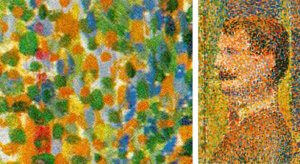 There is an art to being a manager, especially a great one. Like an artist, managers are tasked with bringing the vision of their patron, or company in this case, to life using the resources they have at hand.
There is an art to being a manager, especially a great one. Like an artist, managers are tasked with bringing the vision of their patron, or company in this case, to life using the resources they have at hand.
And that’s the Point-illism
There are many techniques that artists use to create their works. Some use broad brush strokes, others fling paint. Some use chisels or fire while other artists sculpt. I’m sure you’ve experienced managers that have used similar techniques in the workplace. Art is, in the end, about the artist just as managing is about the manager.
“Gallup’s research shows that about one in 10 people possess high talent to manage. Though many people have some of the necessary traits, few have the unique combination of talent needed to help a team achieve the kind of excellence that significantly improves a company’s performance.”1
For an artist or manager to be great, they have to understand themselves and understand how they are viewed by others. Their body of work becomes a self-portrait.
One Technique to Master
There is one technique that all managers should master: Pointillism
“Pointillism is a technique of painting in which small, distinct dots of color are applied in patterns to form an image.”2 “The technique relies on the ability of the eye and mind of the viewer to blend the color spots into a fuller range of tones.”3
The Build-Up
From a manager’s perspective, how you are viewed by your direct reports, coworkers, and leadership is the build-up of all the little things you do every day.
Dark points or dots are applied when you yell, dismiss, ignore, take credit for others work, gossip, backstab, etc. Lighter points are applied when you exhibit empathy, compassion, care, and concern for your employees’ careers and overall well-being. Managers that who adopt the old command and control paradigm will have darker portraits than managers who focus on the development of their employees’ careers and networks.
Limited Resources
In another similarity with artists, managers have limited resources. In Pointillism, artists utilize only three colors: blue, red, yellow. It is the size of the dots (points) and their relation to the other colors that causes the eye to see a broader range of colors. For managers, it’s about finding the right mix of people for their team, the right mix of skills for each project, and the right mix of opportunities for each employee.
Do you get the Point-illism?
We are all Pointillists. What “impression” does your art leave?
1 Adkins, Amy. “Only One in 10 People Possess the Talent to Manage.” Gallup.com. Gallup, Inc., 13 Apr. 2015. Web. 16 Sept. 2015. <http://www.gallup.com/businessjournal/182378/one-people-possess-talent-manage.aspx>.
2 “Pointillism.” Wikipedia, Wikimedia Foundation, 24 Aug. 2017, en.wikipedia.org/wiki/Pointillism. Accessed 7 Sept. 2017.< https://en.wikipedia.org/wiki/Pointillism >
3 Ibid.
Photo credit: Principle Art Talk < https://principlearttalk.com/2015/06/02/technique-tuesdays-pointillism/ >
Let’s Engage!
I’m Agent in Engagement Simpson…Gregory F Simpson.
Employee engagement is a critical mission. I hope I can count on your help! Subscribe to the RSS Feed to receive the latest intelligence/insights and/or register to make entries in the comments log.
 You can follow me @agtinengagement.
You can follow me @agtinengagement.
Email me at g…@a…t.com.
Connect via LinkedIn at LinkedIn.com/in/GregoryFSimpson.
Learn more about me at gregoryfsimpson.com.
P.S. First contact? Welcome to the Agent In Engagement community. Explore and join fellow employee engagement operatives in targeting a known thief – alias: Disengagement. Together we can bring this thief to justice and make the world a better place for all companies and their employees.
Other recent Agent in Engagement data/reports by Agent Gregory F Simpson:
- Employee Engagement Intelligence Briefing: 2017.08.28 – 2017.09.01
- Veteran Operative Employee Engagement Insights: 08.28 – 2017.09.01
- Employee Engagement-Related Spotlight Articles of August 2017
- Agent In Engagement Top 10 Employee Engagement Books – 2017 Edition
- Employee Engagement-Related Spotlight Articles of July 2017
- Employee Engagement-Related Spotlight Articles of June 2017
- 15 Go-To Sources of Employee Experience/ Employee Engagement Articles
